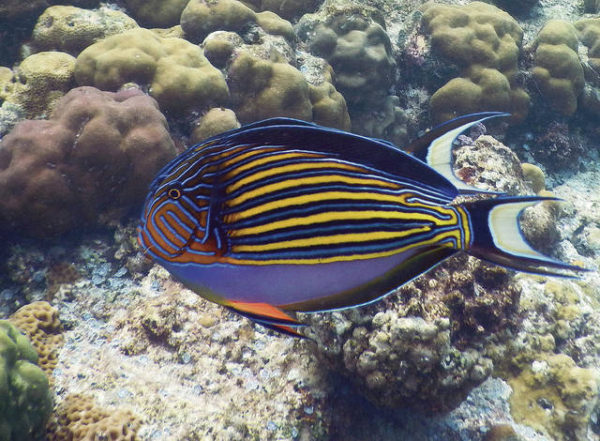Published in the Ocean Watch column, Honolulu Star-Advertiser © Susan Scott
February 17, 2018
KOROR, Palau >> Craig and I are in Palau again and are anticipating another week of great snorkeling. How great? This is my fifth time here. It’s that good.
The Republic of Palau lies roughly between, and south of, Guam and Manila, about 400 miles north of the equator. Of the approximately 700 islands that make up the country, people live on only 12. The total resident population is about 20,000.
This small human populace is one of the country’s charms, along with the stunning beauty of its Rock Islands, hundreds of coral species and over a thousand species of fish. One of my favorite snorkeling finds here are the clams. Seven of the world’s nine species of giant clams dazzle Palau’s waters.
 This spectacular lined surgeonfish is
This spectacular lined surgeonfish is
extremely rare in Hawaii but common in Palau.
©2018 Susan Scott
The people of Palau appreciate their extraordinary natural treasures, and as a result, this tiny country is a leader in conservation efforts. In 2009 the president declared Palau waters a shark sanctuary, the first country to do so. In addition, 58 percent of Palau’s marine environment is protected from fishing, an acknowledgment of the reef’s importance for tourism and as a food source.
In 2012, UNESCO added Palau’s Rock Islands as a World Heritage Site.
Palau’s corals are also getting attention for their ability to thrive in warm, acidic water, factors that are killing corals in other parts of the world.
With global warming heating up the oceans, some hard corals have been spitting out their algae buddies, leaving the corals’ stony skeletons white. This is the so-called bleaching we hear so much about. When the water cools down again, the corals can grab passing algae and recover. If the water stays overly warm, though, the corals die.
Besides warming the water, about one-third of the carbon dioxide we humans are adding to Earth’s atmosphere gets mixed into ocean water, making it more acidic. This, among other things, makes corals unable to absorb the calcium carbonate they need to maintain their skeletons.
Some of Palau’s enclosed bays are naturally warmer and more acidic than open ocean water, however, and the corals in those areas are thriving. This has been an exciting discovery for scientists who are studying coral adaptation, conservationists who see the bay corals as hope for the future, and Palau residents, who depend on their reefs for food and tourism.
Like every human-inhabited place on the planet, Palau has its problems, such as invasive species and visitors loving the place to death. The positive far outweighs the negative, though, making Palau one of my favorite places to go back to. And back to. And back to …
For snorkeling in Palau, I highly recommend the Oceanic Society, goo.gl/kMig9F, a nonprofit group dedicated to conserving marine wildlife by deepening connections between people and nature.